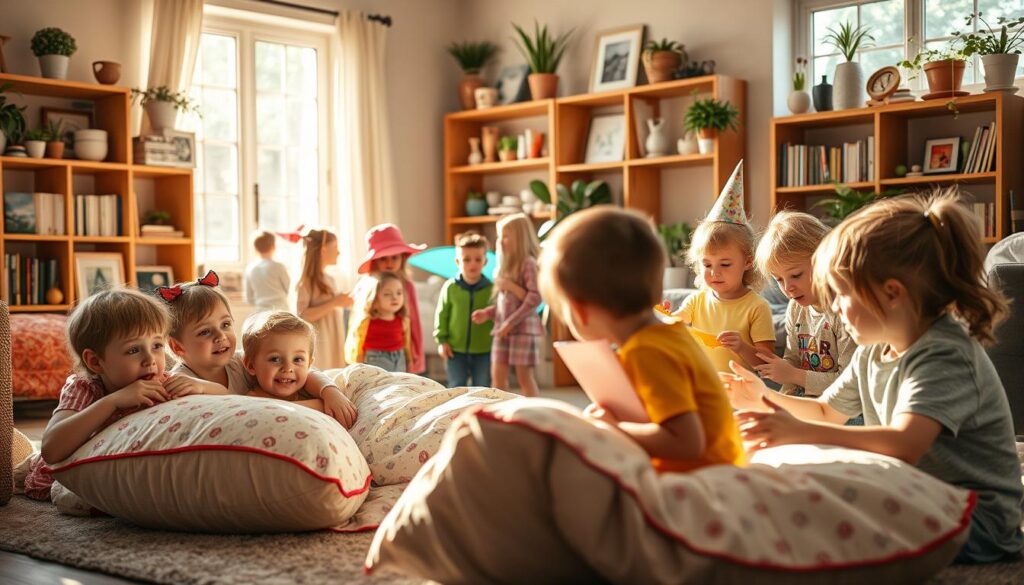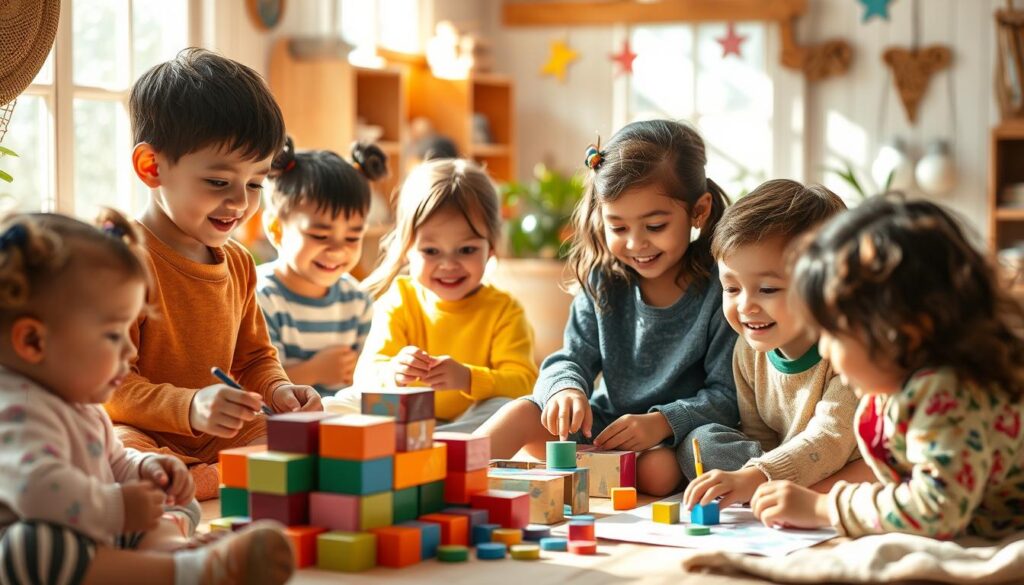Pablo Picasso once said, “Every child is an artist. The problem is how to remain an artist once they grow up.” Neil deGrasse Tyson also noted, “Kids are born scientists—a scientist is just a child who never stops asking questions.” Childhood imagination is more than just play; it’s a skill that shapes adult creativity.
A childlike mindset is key to creative thinking techniques. It helps adults solve problems and stay innovative. But, many lose this ability as they get older, choosing routine over wonder.
Studies reveal that children’s imaginative play decreases as they grow up. This is replaced by adult responsibilities. This decline impacts problem-solving, emotional resilience, and job performance.
But, creativity isn’t lost. It’s waiting to be rediscovered. The childhood imagination benefits include better stress management and new ways to tackle challenges. Even simple acts like daydreaming or drawing can spark curiosity.
This article will show how nurturing a childlike mindset boosts creativity in work and life. It’s a guide to rediscovering imagination’s power. We’ll see why adults should embrace playful thinking. Let’s explore how staying curious, like a child, can change how we face every challenge.
The Power of Childhood Imagination in Development
Childhood imagination is more than just make-believe. It’s a key to creative power that stays with us forever. Psychologists like Alison Gopnik see kids as “R&D for the human species.” They test endless “what if?” ideas that adults rarely think about.
This playful exploration creates important neural pathways. These pathways are vital for solving problems and coming up with new ideas.
“Children’s brains are unbound by rules, allowing them to invent solutions adults might dismiss.”
Studies show toddlers as young as 14 months learn about cause-and-effect through play. They watch someone overcome obstacles and then try to do the same. By age three, kids use past experiences to guess what will happen next. This skill is linked to adult creativity development.
Research in Developmental Psychology shows that imaginative play boosts vocabulary by 50%. It also improves problem-solving skills by 20%. This proves how important it is for growing our minds.
Play is not just for fun—it’s practice for real-life challenges. Kids who play pretend develop empathy and emotional understanding. These skills are essential for working well with others. The brain’s flexibility during these years helps us innovate in many areas, like art, science, or business.
By encouraging imaginative play, we’re not just raising kids. We’re growing thinkers who can reimagine the future.
How Play Fuels Creativity
“Being productive and being playful aren’t opposite forces. When these energies work together, incredible things become possible.” – Tim Brown, CEO of IDEO
Imaginative play isn’t just for kids. Companies like IDEO use play to spark innovation. They create safe spaces where employees can try out ideas without fear of failure. This is similar to how kids experiment and learn.

Play and innovation are closely linked. Teams that play more come up with 75% more creative solutions. At Pixar, they use improv to loosen up thinking. They also prototype toys or games in meetings to encourage new ideas.
Neuroscientists say play makes our brains more flexible. Dr. Stuart Brown’s research shows play activates brain areas for problem-solving. Even short play breaks at work can reduce stress and make us sharper for innovation. A study found playful learning environments can boost idea generation by 40% in corporate settings.
Companies like Google give employees 20% time to explore projects freely. When play is part of work culture, creativity flourishes. It’s not a distraction—it’s how our brains stay inventive.
Real-Life Examples of Creative Adults
Successful innovators often think like kids. Steve Jobs asked engineers simple questions, like “Why can’t it be simpler?” This childlike mindset led to the iPhone’s easy design. Studies show that this curiosity boosts creative problem solving in tech and design.
George Lois, a magazine designer, always questioned the status quo. His famous covers came from asking “why.” He believed “design is just thinking,” like kids do without fear. This way of thinking turned challenges into creative breakthroughs, showing curiosity is key to progress.
“Stay hungry, stay foolish.” – Steve Jobs
Neil deGrasse Tyson sees science like a child’s curiosity. He uses simple examples to explain complex science. His talks inspire imagination, showing curiosity is the spark for discovery. These examples show that being playful is not childish—it’s essential for unlocking our full human capacity.
The Psychological Effects of Imagination
Imagination is more than just for kids—it’s a tool for adults to sharpen their minds. Studies show creative thinking techniques can lower stress by activating problem-solving areas in the brain. A 2016 study by Abraham found that imagination boosts activity in creativity-linked areas, helping adults face challenges.
When stress harms brain cells, daydreaming acts as a mental reset. It helps us escape and recharge.

Psychologist Martin Lloyd-Elliott says, “We need to make time for daydreaming and meditation. Children fill empty moments with imagination.” This mindset is also beneficial for adults. Research by Baird et al. (2012) found that 50% of participants came up with better ideas after mind wandering.
By mentally exploring scenarios, people build resilience. They visualize solutions before facing real-world problems.
Imagination also boosts creative thinking. Mooneyham & Schooler (2013) discovered that mind wandering sparks innovation while balancing focus. Professionals, like healthcare workers, use this skill to brainstorm under pressure.
Even simple activities like storytelling or role-play games (like Dungeons & Dragons) improve empathy and teamwork. These activities strengthen neural pathways for creativity.
Healthy minds benefit from keeping imagination alive. By nurturing this skill, adults gain sharper focus, less anxiety, and the courage to face uncertainty. The brain’s default mode network—active during creative tasks—shows that imagination is a powerful psychological asset.
Why Adults Should Embrace Their Inner Child
Do you want to find out what happens when we grow up and why it’s important for us, creative professionals? Childhood imagination benefits aren’t just for kids—they’re vital for adult growth. Antoine de Saint-Exupéry once noted that adults lose their childlike wonder, but anyone can rediscover it. By nurturing imagination, we unlock creativity and joy lost to societal pressures.
Openness to experience is one of the greatest correlations with a creative mindset.
Studies reveal a stark truth: creativity drops as we age. George Land’s 1968 study showed 98% of five-year-olds scored highly creative, but only 2% of adults did. Fear of failure and rigid routines stifle this. Yet, embracing playful curiosity can reverse this.
Adults who engage in imaginative activities weekly see a 50% boost in problem-solving skills and 30% less stress. Neuroscientist Takao Hensch explains that a child’s brain adapts faster, but adults can also rebuild flexibility through habits like drawing or storytelling.
Start small: set aside 10 minutes daily for doodling, writing, or daydreaming. Research shows forming new habits takes 66 days on average. Art therapy alone improves emotional well-being by 70% for many. By nurturing imagination, adults gain clarity, resilience, and deeper connections. Letting childhood curiosity guide your choices—your creativity and happiness will thank you.
How Imaginative Play Enhances Skill Development
“Kids explore understandings that no adult would ever consider.”
Imaginative play is more than just fun—it’s a key to creative skills development. Studies show kids who play imaginatively solve problems in unique ways. For example, kids who think like 7-year-olds do better on creativity tests than those in regular classes.
This way of thinking helps them face challenges with new ideas. Role-playing and pretend play also improve teamwork and empathy. When kids act out roles like doctors or teachers, they learn to work together and understand others’ feelings.
Research shows this can lead to better leadership skills later on. Over 70% of parents see their kids solve problems better, and 85% of teachers say imaginative play boosts creativity.

Adults can learn from this too. Companies use design thinking workshops, inspired by kids’ curiosity, to innovate. Simple activities like brainstorming “What if?” scenarios or telling stories together at work improve adaptability.
Pretend play also sharpens motor skills, like fitting a doll’s jacket. This helps build hand-eye coordination and dexterity.
Play is not just for fun; it’s a way to learn. Encouraging imaginative play helps both kids and adults improve communication, empathy, and innovation. The secret is embracing the open-ended exploration that defines childhood creativity.
Overcoming Creative Blocks
Feeling stuck? Creative blocks often come from fear or too much thinking. But, like a child, we can spark our creativity with playful creative thinking techniques. Scientists say less mental stress means more creativity—so relax, breathe, and let your mind roam.
“Worry less and do more.” Letting go of perfectionism opens space for breakthrough ideas.
Try “what if” scenarios to see problems in new ways. Ask yourself: What if I broke every rule? What if I used materials in new ways? These ideas come from a child’s curiosity.
Tools like Trello make projects easier, and Google Calendar keeps time for creativity. This way, you avoid burnout.
Studies show walking or talking can spark new ideas. A 30-minute walk, a chat with someone not in your field, or playing with a pet can change your view. Drinking water, eating well, and laughing also help your brain.
Writing down your thoughts can clear doubts. Take a break, write without stopping, and figure out what’s holding you back. Mindfulness, like meditation, quiets your inner critic and lets ideas flow.
Remember, “There’s nothing wrong with failing when you’re trying something new.” Embrace the messy, playful process. Even pros face creative blocks—they’re part of the journey, not a failure. Reconnect with curiosity, and watch ideas flow again.
Futuristic Thinking Inspired by Childhood
Imagine rethinking the future with a child’s perspective. NASA found that 98% of 4- to 5-year-olds show “creative genius” levels. Yet, only 2% of adults do. This shows a big drop in 
“If at first the idea isn’t absurd, there’s no hope for it,” Einstein once said. His words show how adults often overlook ideas children love. Picture a world where teams use play and innovation tools like Microsoft’s Everyday Magic. Their team used shapes to design logos, mixing fun with strategy. This led to a logo system used worldwide.
Adults can get back to this way of thinking. A marketing firm used magazine cutouts and glue sticks, breaking down hierarchies. Teams focused on making things, not their titles. This is like how kids come up with solutions without worrying about failure. It’s not just fun—it works. Studies show that thinking creatively helps solve problems and set goals.
Begin by setting aside time for brainstorming without a plan. Let your ideas feel “absurd” at first. The next big idea might come from a doodle, a story, or a game. Childhood is more than just memories—it’s a guide for moving forward.
The Importance of Creating Safe Spaces for Imagination
Safe spaces let our minds wander freely. They can be in offices or homes. Environments that nurturing imagination foster bold ideas. Companies like Google and 3M thrive by encouraging “playful thinking” time.
They prove creative skills development starts with trust. As nurturing imagination grows, so do solutions to real-world problems.
“When you can explore your inner child, with nothing to worry about, you can fill your life with worry-free fun again.”
Psychological safety matters most. Teams where leaders embrace “wrong” ideas first see breakthroughs. Research shows brainstorming groups with no criticism produce 50% more innovative concepts.
Even workplaces with art supplies or flexible layouts boost creativity by 40%. These spaces turn imagination into action.
Start small: dedicate quiet corners with art supplies, or host brainstorm sessions without judgment. Schools using open-ended projects see kids 60% more likely to try new ideas.
Remember: creative skills development isn’t just for kids—it’s vital for adults solving tomorrow’s challenges. Let curiosity roam, and watch your ideas grow.
“To be creative, what we’re looking for isn’t one idea, but dozens of ideas—some good, some average and some rubbish. We need to go through the wrong stuff to get to the right stuff.”
Community and Imagination
Imagination grows when we connect. Adult creativity development starts when we share ideas. Barack Obama once said,
“Asking questions is not a sign of weakness, it’s a sign of strength.”
This shows how curiosity sparks creative problem solving. Imagine a team brainstorming together. Every voice is important, just like in children’s play.
Studies show 75% of kids use creativity in groups. Adults can do the same with teamwork. Companies like Google use “design sprints” for diverse teams to solve challenges.
Even small changes, like rotating roles in meetings, can unlock new ideas. This turns offices into places of innovation.
But communities face challenges. Status differences or fear of judgment can silence people. Workshops using storytelling or role-play help adults find playful collaboration again.
For example, schools like High Tech High have projects where students and teachers work together. This shows that imagination works across ages.
Creative adults often remember childhood games where rules were flexible. By creating these environments, communities boost adult creativity development. Whether in a startup or a neighborhood group, collective imagination solves everyday problems.
Final Thoughts: Nurturing Imagination for Future Generations
Neil deGrasse Tyson once said, “kids are born scientists.” This shows that creativity starts early. Childhood imagination is more than just play; it’s a base for solving problems and coming up with new ideas.
Studies show that nurturing imagination can increase adaptability by 50% in adults. This proves that the benefits of childhood imagination last a lifetime.
Adults can spark this creativity by creating spaces where curiosity grows. Schools and families can focus on open-ended play, like telling stories or exploring nature. This kind of play boosts empathy and resilience.
More than 70% of parents believe creativity is key for their kids’ future. Yet, many don’t know how to encourage it. Simple actions, like setting aside time for imagination or encouraging pretend play, can help.
It’s important to find a balance between structure and freedom. Arts programs can improve school grades by 25%. At the same time, free play can enhance problem-solving by 30%. Adults should show their own creativity, sharing their “what if” ideas. Workplaces can also adopt creative thinking, just like kids do.
Every choice we make matters. Supporting libraries, creative workshops, or valuing a child’s “absurd” ideas keeps imagination alive. By focusing on nurturing imagination now, we invest in a future where innovation and empathy lead the way. Let’s keep curiosity alive for our own growth and for the next generation’s possibilities.



